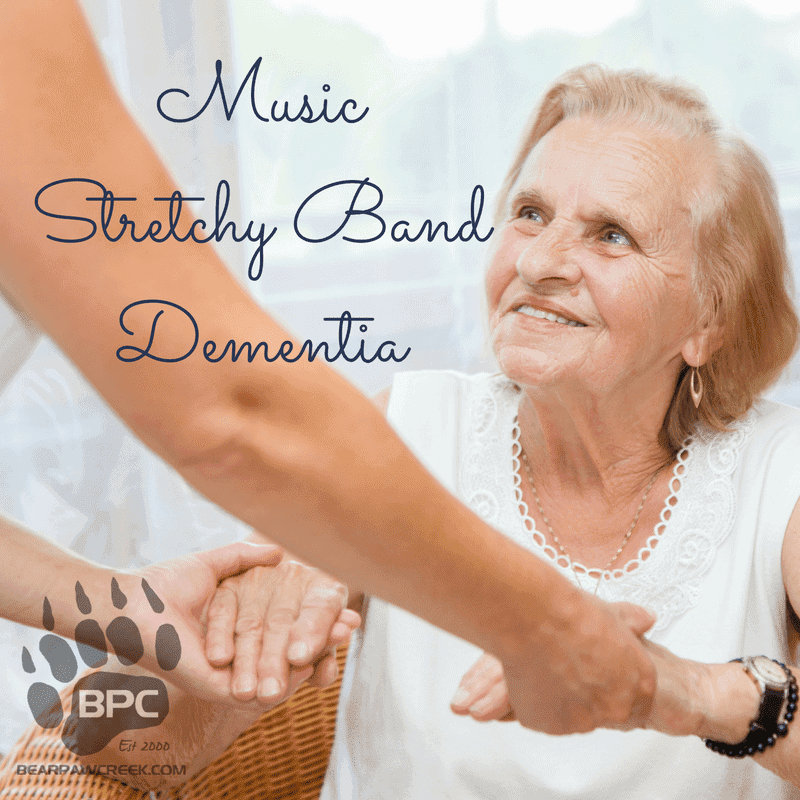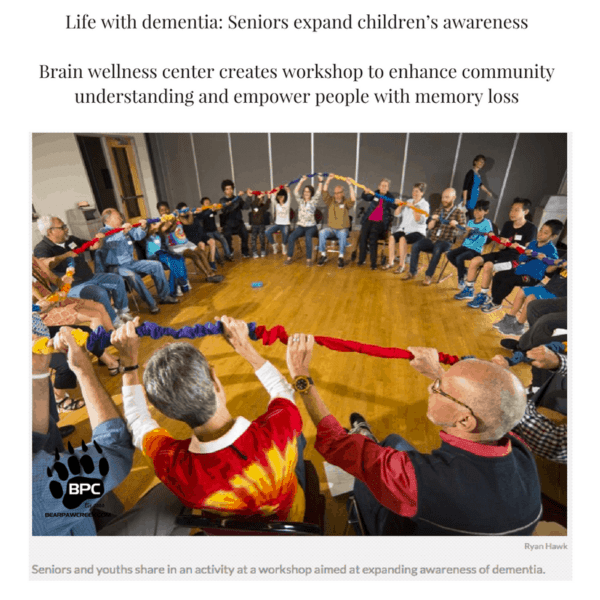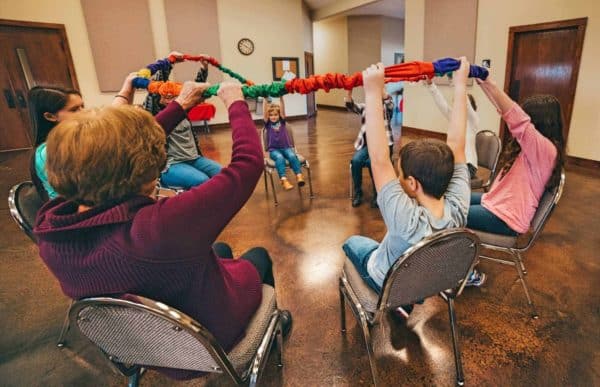Stretchy Band Movement Prop, Music, and Dementia
A few years ago we went with our neighbor’s to a local assisted living facility. Caroline’s Dad lives there, and they head over once a month with their guitar, banjo, voices and meet some friends to put on a show for the residents.
Some of our children were able to join in the band that night, while some of us joined the audience. Music is a universal connector of people, isn’t it?
One lady in particular could sing every song, and belt it out perfectly. Yet – once the music stopped, it’s as if her brain froze.
The power of music on the brain fascinates me. I am so glad there is more research being done and those of you that are working to bring care and awareness.
This post will showcase some ways you can use the stretchy band in dementia care.

The Connect-a-Stretchy Band and Dementia
The Connect-a-Stretchy Band from Bear Paw Creek, is a staple in my bag of tricks! I love it because it can be used with all age groups to meet a variety of goals. An indispensable feature is that it can be re-sized easily and immediately to fit the size of your groups. One of my favorite places to use the Connect-a-Stretchy Band is with my groups who have dementia. I often walk into these facilities to find people sitting together in a room, but not interacting with each other. They may be sleeping, watching t.v., confused, depressed or irritable. The Connect-a-Stretchy Band is an invaluable tool to help clients who have difficulty socializing, become engaged and “connected” to others.
After a warm up period of singing familiar songs and perhaps, a Hello, song, I introduce the Connect-a-Stretchy Band. While sitting in a circle with everyone holding it, I strum the autoharp to encourage gross motor movements – up & down, in & out, side to side. We’ll move and sing to familiar songs like Edelweiss or Take Me Out to the Ballgame. I also use recorded music so I can also participate and help guide movements. People who are sleeping or perhaps confused, are automatically connected and supported by their neighbor’s movements. It’s not unusual to see clients wake up, begin smiling and singing. It’s important to remember to keep movements simple and take into account health issues that may impact their abilities such as arthritis. However, once they hear a favorite song or dance, you may find your clients moving to the beat in ways they haven’t in years.
@RhythmWorksMT shares the way they use the stretchy band with dementia care. Share on X
Is Music the Key to Trigger Memories?
This beautiful article features the stretchy band in use at an amazing event in August 2016. The workshop was created by Marigrace Becker of the Memory and Brain Wellness Center, part of the UW Medicine Neurosciences Institute. Its underlying purpose, she said, is to empower people living with memory loss and their care partners to become social activists in raising in community awareness.
Activities were designed for people of all ages and abilities. In a seated circle dance led by Susan Wickett-Ford of Silver Kite Community Arts, everyone held onto a stretchy band of rainbow-colored fabric, which they moved up and down and side to side to a classic Breton folk song. The circle’s members had to work together and rely on each other to maintain the dance.

I agree wholeheartedly with Becker when she states: “Ultimately, I want to see more and more of these workshops happening all around the world, simultaneously,” Becker said. “The time has come to recognize that people living with memory loss can lead the way in building communities that are welcoming, understanding and accessible to all.”
Take a moment to see some clips from their day. Truly inspiring.
Movement, Dance, and Dementia Resource
A few highlighted quotes from the article:
There is a growing recognition that exposure to the arts can help dementia sufferers to reconnect with themselves and even slow their rate of decline. Increasingly, music is helping doctors and carers reach those who have become stranded by this debilitating condition.
These 60-minute sessions reveal previously hidden aspects of the patients to their carers; likes and dislikes, talents and memories – it all helps piece together the jigsaw of an identity obscured by illness. “Perhaps that patient reveals a love for a film or a place, a time or an event; something that carers didn’t know about but can use in their communication with that patient, another way to connect with a seemingly closed personality. It’s a glimpse of the real person underneath,” said Meynell.
Some of the movement props suggested are: scarves, feathers, stretchy bands, parachutes, balloon, hats, and fans.
I hope this post will encourage your engagement with sufferers of dementia. I hope we can continue to integrate the aged with the young, we all benefit greatly from multi-generational activities.
Shop Stretchy Band Options be clicking on the image below:



I love this post. I truly hope to see a breakthrough in dementia treatment which includes both finding the cause and treating it to using effect therapy for intervention, stimulation and social connection.